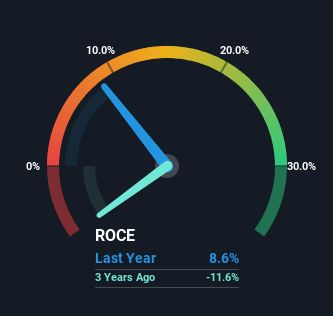- United States
- /
- Airlines
- /
- NasdaqGS:AAL
Returns At American Airlines Group (NASDAQ:AAL) Appear To Be Weighed Down
Finding a business that has the potential to grow substantially is not easy, but it is possible if we look at a few key financial metrics. Firstly, we'll want to see a proven return on capital employed (ROCE) that is increasing, and secondly, an expanding base of capital employed. Put simply, these types of businesses are compounding machines, meaning they are continually reinvesting their earnings at ever-higher rates of return. Although, when we looked at American Airlines Group (NASDAQ:AAL), it didn't seem to tick all of these boxes.
Understanding Return On Capital Employed (ROCE)
If you haven't worked with ROCE before, it measures the 'return' (pre-tax profit) a company generates from capital employed in its business. Analysts use this formula to calculate it for American Airlines Group:
Return on Capital Employed = Earnings Before Interest and Tax (EBIT) ÷ (Total Assets - Current Liabilities)
0.086 = US$3.3b ÷ (US$62b - US$24b) (Based on the trailing twelve months to December 2024).
Thus, American Airlines Group has an ROCE of 8.6%. Even though it's in line with the industry average of 8.9%, it's still a low return by itself.
Check out our latest analysis for American Airlines Group

In the above chart we have measured American Airlines Group's prior ROCE against its prior performance, but the future is arguably more important. If you'd like, you can check out the forecasts from the analysts covering American Airlines Group for free.
What The Trend Of ROCE Can Tell Us
There hasn't been much to report for American Airlines Group's returns and its level of capital employed because both metrics have been steady for the past five years. It's not uncommon to see this when looking at a mature and stable business that isn't re-investing its earnings because it has likely passed that phase of the business cycle. With that in mind, unless investment picks up again in the future, we wouldn't expect American Airlines Group to be a multi-bagger going forward.
What We Can Learn From American Airlines Group's ROCE
In summary, American Airlines Group isn't compounding its earnings but is generating stable returns on the same amount of capital employed. And in the last five years, the stock has given away 37% so the market doesn't look too hopeful on these trends strengthening any time soon. All in all, the inherent trends aren't typical of multi-baggers, so if that's what you're after, we think you might have more luck elsewhere.
If you want to know some of the risks facing American Airlines Group we've found 3 warning signs (2 can't be ignored!) that you should be aware of before investing here.
If you want to search for solid companies with great earnings, check out this free list of companies with good balance sheets and impressive returns on equity.
New: Manage All Your Stock Portfolios in One Place
We've created the ultimate portfolio companion for stock investors, and it's free.
• Connect an unlimited number of Portfolios and see your total in one currency
• Be alerted to new Warning Signs or Risks via email or mobile
• Track the Fair Value of your stocks
Have feedback on this article? Concerned about the content? Get in touch with us directly. Alternatively, email editorial-team (at) simplywallst.com.
This article by Simply Wall St is general in nature. We provide commentary based on historical data and analyst forecasts only using an unbiased methodology and our articles are not intended to be financial advice. It does not constitute a recommendation to buy or sell any stock, and does not take account of your objectives, or your financial situation. We aim to bring you long-term focused analysis driven by fundamental data. Note that our analysis may not factor in the latest price-sensitive company announcements or qualitative material. Simply Wall St has no position in any stocks mentioned.
About NasdaqGS:AAL
American Airlines Group
Through its subsidiaries, operates as a network air carrier in the United States, Latin America, Atlantic, and Pacific.
Solid track record and good value.
Similar Companies
Market Insights
Community Narratives



